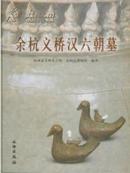
余杭义桥汉六朝墓(精)
全新正版 极速发货
¥ 216.73 6.8折 ¥ 320 全新
仅1件
广东广州
认证卖家担保交易快速发货售后保障
作者杭州市文物考古所. 余杭区博物馆.
出版社文物出版社
ISBN9787501030118
出版时间2010-08
装帧其他
开本其他
定价320元
货号1844204
上书时间2024-05-26
- 最新上架
商品详情
- 品相描述:全新
- 商品描述
-
目录
第一章 概况
第一节 地理环境
第二节 历史沿革
第三节 发现与发掘概况
第四节 资料整理和报告编写
第二章 单位墓葬详述
第一节 两汉墓葬
一 土坑墓
(一)一墩一穴土坑墓
1.长方形土坑墓
(1)长方形窄坑
M30
M38
M18
M2
M39
(2)长方形宽坑
M33
M3
M10
M42
M59
M17
M19
2.刀把形土坑墓
M29
M50
(二)一墩二穴土坑墓
1.M35和M36
刀把形宽坑M35
长方形窄坑M36
2.M46和M47
长方形窄坑M46
长方形宽坑M47
3.M57和M58
长方形宽坑M57
刀把形窄坑M58
(三)一墩三穴土坑墓
长方形宽坑M56A
长方形窄坑M56B
刀把形窄坑M56C
(四)其他
M28
M37
M60
二 砖室墓
(一)长方形砖室墓
1.前后室结构墓
M13
2.单室结构墓
M6
M8
M31
M43
M45
M48
M51
M52
M53
M54
M62
(二)凸字形砖室墓
1.前后室结构墓
M207
2.单室结构墓
M1
M34
M44
(三)T字形砖室墓
M14
(四)其他
M9
M12
M15
M32
三 采集遗物
第二节 六朝墓葬
一 长方形砖室墓
M41
M16
二 凸字形砖室墓
(一)前后室结构
M7
M22
M40
M4
(二)单室结构
M21
M23
M24
M25
三 刀把形砖室墓
M20
M55
四 T字形砖室墓
M11
第三章 墓葬形制与出土遗物类型
第一节 墓葬形制
一 土坑墓
二 砖室墓
第二节 出土遗物类型
一 陶器
(一)质地
(二)制法
(三)釉
(四)纹饰
(五)器形
1.仿铜陶礼器
2.生活用器
3.模型明器
二 瓷器
(一)青瓷
(二)黑(酱)釉瓷
三 铜器
四 铁器
五 其他
(一)银器
(二)琉璃器
(三)石器
第四章 分期与年代
第一节 墓葬分组
第二节 分期与年代
第三节 各期墓葬形制的发展和随葬品组合的演变
一 墓葬形制的发展
二 随葬品组合的演变
第五章结语
第一节 墓地选择与墓葬分布
第二节 葬俗
第三节 墓地性质
第四节 汉墓文化因素分析
第五节 汉墓中的合葬习俗
第六节 墓地特点
附表一 土坑墓登记表
附表二 砖室墓登记表
附表三 出土铜镜统计表
附录一 战国墓葬
附录二 宋代墓葬
附录三 明清墓葬
后记
英文提要
内容摘要
TheYiqiao义桥cemetery(N30°17’40”,E119°54’07”)is4kmnorthwestoftheYuhang余杭TowninwesternYuhangDistrict,Hangzhou杭州City,Zhejiang浙江Province,and2.5kmnorthoftheTiaoxi苕溪Spring,betweentheTianmushan天目山Mountainsinitswestandsouth,andtheplainareainitseast.ItisontheslopesofseveralsmallhillsincludingtheSheshantou蛇山头hill,theGuojiatou郭家头hillandtheWangjiashan王家山hill,withtheYiqiaoVillageinitseast,theNo.15provincialhighwayinitsnorth,theYangmeiling杨梅岭andXin’anqian新庵前VillagesinitswestandtheAnshan安山Villageinitssouth.Thehillswhichare4to28metersabovesealevelwerecoveredbyteatreesbeforebutnowhavebeenlefthncultivatedduetothelocalindustrialdevelopment.InApril2007,ancientburialswereunearthedduringtheconstructionoftheYuhangIndustryDevelopmentLimitedCompany.Aftersigninganagreementwiththedeveloper,theHangzhouMunicipalInstituteofCulturalRelicsandArchaeologyandtheYuhangDistrictMuseumorganizedacooperativearchaeologicalteamandconductedasalvageexcavationfromMay22ndtoJuly10th,duringwhich64burialshadbeendiscoveredinanareaof1500sqmeters.Theburialsinclude1ofthepre—Qinperiod,47oftheHan汉Dynasty,13oftheSixDynasties,2oftheSong宋Dynastyand1oftheQing清Dynasty.Totally522pieces(sets)artifactswereunearhed.Besides,63piecesofartifactsprobablyfromtheburialshadbeencollected.Thismonographisadetailedreportonthe60burialsoftheHanDynastyandtheSixDynasties.Informationoftheotherfourburialsisintheappendix.Collectedartifactsofdifferentperiodsaredescribedafterthereportsoftheburialsoftheirrelatedperiods.The60burialsoftheHantotheSixDynastiesperiodscanbedividedintotwotypes:earth—shaftburialswhicharerelativelywellpreserved,andthebrick—chamberburialsmanyofthewhichhadbeenlootedlongago.Theearth—shaftburialscanbefurtherdividedintotwosub—types:therectangular—shapedburialsandthehandIe—knife—shapedburials.Someshaftsarewiderandsomearenarrower.Thebrick—chamberburialsarerectangular—shaped,凸—shaped,handle—knife—shapedorT—shaped.Somehavefrontandbackchambers.Burialsofferingsintheearth—shaftburialsarerelativelylargerinnumberandmorevariousintypescomparingwiththoseinthebrick—chamberburials.Totally406pieces(sets)ofceramic,porcelain,bronze,iron,silver,stoneandglassofferingswereunearthedfromthe60burials.Ceramicobjectstakethehighestpercentage,followedbyporcelainobjectsandbronze/ironobjects.The321ceramicobjects(79.1%ofthetotalartifacts)aremainlygray—brownorgray—greenincolorandgreen—yellowglazed.Theyobviouslybelongtothegreen—glazetraditionoftheSouthernChina.Mostofthemwerehand—made,somewiththehelpofmoulds,andwheelmended.Mainsurfacedecorationsincludethestring—patternandcurvedflourishdesigns.Someofthemareimitationsofbronzeritualvessels.Somemighthavebeenarticlesfordailyuse,somewerespeciallymadeasburialofferings.Sixteenbronzemirrorsandtwoironding鼎tripodswerefoundintheburials.Onlytwooutofthe60burialshavedirectstratigraphicrelationshipsandnoneofthemhaveartifactswithaccuratedate.Mainlybasedonthestructuresoftheburialsandtypologicalresearchonburialofferings,wedividedtheburialsintoeightphases:phaseⅠdatingtotheearlyWesternHan,phaseⅡdatingtotheMiddleWesternHan,phaseⅢdatingtotheLateWesternHan,phaseIVdatingtotheXinMang新莽period,phaseVdatingtotheEarlyEasternHan,phaseVIdatingtotheMiddleandLateEasternHan.phaseVIIdatingtotheWesternJin晋andphaseⅤⅢdatingtotheEasternJin.Somerulescanberecognizedfromthedistributionofburials.Seventeenearth—shaftburialsarelocatedontheslopesofthehillsnearGuojiatouinthenorth,whilenineareontheslopesofthehillsnearSheshantouinthesouth.Itseemsthatearlierburialsareusuallyhigherandlaterburialshavekeptmovingdownslope.Nineteenbrick—chamberburialsareontheslopesnearGuojiatou,while17ofthemareontheslopesnearSheshantou.Significantly,tenofthe21EasternHanbrick—chamberburialsconcentratedaroundSheshantou.EightofthenineWesternJinburialsareonthewesterntopofSheshantou.TwoofthefourEasternJinburialsareontheeasterntopofSheshantou.EasternHanbrick—chamberburialsareusuallyonthemiddleslope,whilethoseoftheSixDynastiesareusuallynearthetop.Basedontheexcavation,weknowthatthesehillshadbeenusedasburialgroundasearlyasintheWarringStateperiod.Thesmallpopulationsizeresultedinthesmallnumberofburials.ThisareahadbecomeanimportantcemeteryduringtheHanandtheSixDynasties.TheearliestburialsofthisperiodareonthenorthernslopesofGuojiatou.FromtheEasternHan,burialshadgraduallymovedsouthwardtothesouthernslopesofGuojiatouandSheshantou.Alltheearth—shaftburialsareeast—westorienting,whilemostof、thebrick—chamberburialsareeastornorthorienting.Itseemsthatorientationofaburialhascloserelationshipwithitsmicro—landscape—mostoftheburialsorientingtoopenarea.Burialsofthesameperiodandatthesamelocationusuallyheadedtothesamedirection.Passageslope,ercengtai二层台platformoffilledearth,ercengtaiplatformofuntouchedearth,stonesupportersandearthmoundhadbeenfoundinorabovesomeearth—shaftburials.Someburialsareunderthesameearthmound,andsomeburialshavemorethanonedead.InHanDynastyburialswithmorethanonedead,therearesecondaryburiedindividualswhomighthavediedearlierandbeenmovedfromtheiroriginalburials.Nicheswerecommoninthebrick—chamberburialsoftheWesternJin.Thelargestlengthandwidthofearth—shaftburialsare4.5and3meters,whilethoseofthebrick—chamberburialsare6and5meters.Inotherwords,alltheburialsaremiddleorsmallinsize.Thestructure,quantityandqualityofburialofferingsalsoindicatethatthisareaisthecemeteryforcommonpeople.BoththestructureandstyleofburialofferingsdemonstratetheincreasinginfluenceoftheHanculturewhichthendevelopedtotheJinculture.AlthoughlocalculturalelementscanberecognizedintheburialsoftheHanDynasty,theyhadbeengraduallytakenplacebytheHanculturalelements.Wecanfindthehistoricalbackgroundofthistakeoverinancienttexts.Insummary,theYiqiaocemeteryhadbeentheburialgroundforcommonpeople.Theburialswithsignificantlocalcharacteristicsarelargeinnumberandcoveracompletechronologicalsequence.TheyareimportantforourresearchonmortuarypracticeinSouthernChina,especiallyintheJiangzhe江浙areaduringtheHantoSixDynastiesperiod.
相关推荐
— 没有更多了 —



















以下为对购买帮助不大的评价